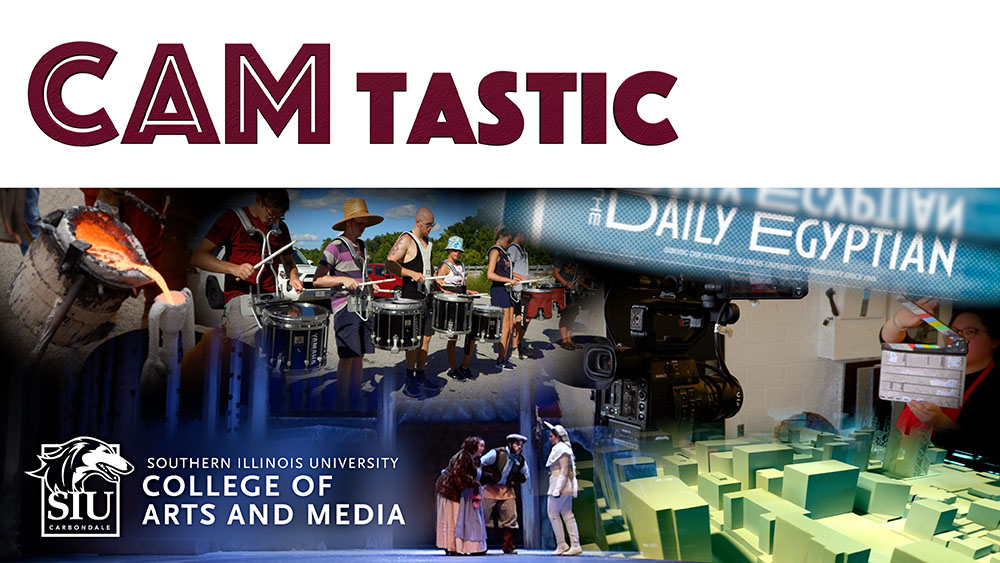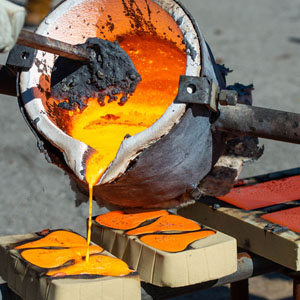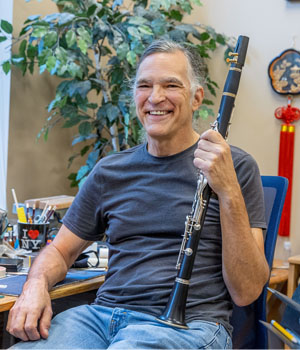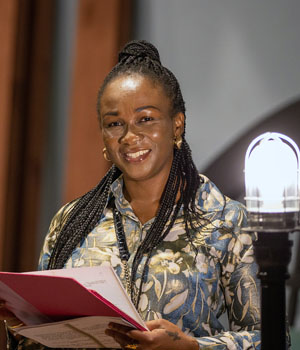CAMtastic Fall 2024 Newsletter
From the Dean: 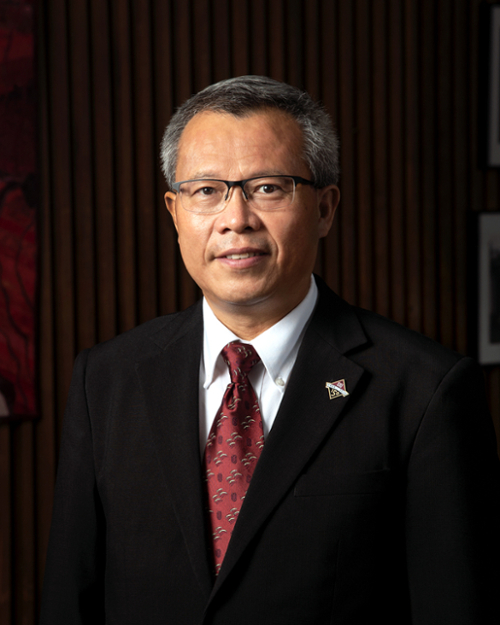
Dear CAM alums and friends:
Greetings from the College of Arts and Media at Southern Illinois University Carbondale. I am thrilled and proud to present the September 2024 issue of CAMtastic, our college’s semiannual electronic newsletter for alums and friends.
This issue briefly glimpses several amazing things happening in our CAM family. You are cordially invited to submit newsworthy items about you and other CAM alums and friends to Mark Stoffel, chair of the CAM Communication Committee, at mstoffel@siu.edu.
Besides the stories you will read in this CAMtastic, I would also like to mention three other things happening in the college. This past June, CAM relaunched its Hollywood Studies program. Thanks to many CAM alums’ enthusiastic support, the CAM School of Media Arts faculty’s tremendous effort and its students’ active participation, this “inaugural” cohort was a huge success. As a support to the program, the SIU Foundation held an inaugural Saluki Takeover Tour in Hollywood. More than 50 CAM alumni attended this event.
CAM has launched a Global Arts and Media Visiting Scholar Program to enhance the college’s international engagement. The first visiting scholar is coming to Carbondale in October.
Most excitingly, CAM's enrollment increased by 3.2% this fall semester compared with last fall. Meanwhile, the college currently has the most robust retention rate on campus.
My heartfelt thanks to our alums and SIU leadership for supporting CAM and CAM colleagues and students for their diligent work and enormous creativity.
I would also like to thank CAM’s donors and friends for the treasure, talent and time they generously offered our students and programs. Gifts from our alums and friends help us provide the top-rate education our students need and deserve. Any amount makes a difference and is welcome. To learn more about giving, contact Lisa Knight at lisak@foundation.siu.edu or Michelle Snyder at michelles@foundation.siu.edu.
Thank you for reading CAMtastic and supporting our remarkable college and this much-needed CAM e-publication. Please take care, stay healthy and keep in touch. I look forward to seeing many of you in person at the 2024 Homecoming in October and various Saluki Takeover Tours throughout this academic year.
Go Dawgs and CAM!
Hong Cheng, Ph.D.
Dean and Professor
College of Arts and Media
Southern Illinois University Carbondale
School of Media Arts professor and students bring the eclipse to the world, liveund the Globe
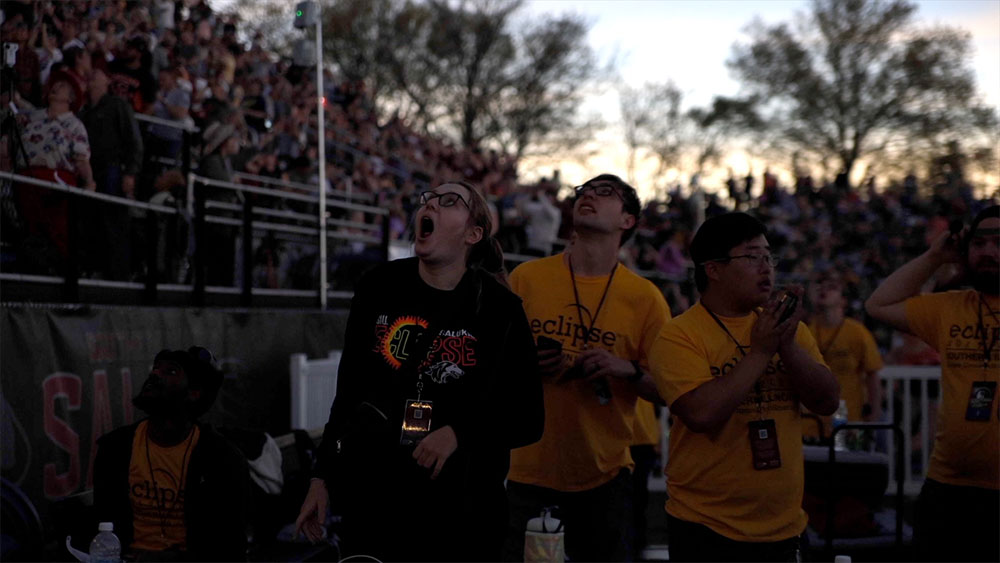 When the moon was creeping in front of the sun at 12:42 p.m. local time on April 8, School of Media Arts Associate Professor Karla Berry and her students were making sure people across the globe could experience the “magical” event.
When the moon was creeping in front of the sun at 12:42 p.m. local time on April 8, School of Media Arts Associate Professor Karla Berry and her students were making sure people across the globe could experience the “magical” event.
Berry has one word for the eclipse: “profound.”
She says of her students, “They worked throughout the academic year to plan and to research the science and the individuals involved in telling the story, and they were overwhelmed with emotion when totality happened.”
One of those students, Kaylee Wobig said, “The moment when I took off my (eclipse) glasses and saw the full eclipse for the first time was indescribable. It truly took my breath away, and I think my jaw was on the floor the entire four minutes and nine seconds.”
Berry gathered students from her electronic media workshop to create content, in advance and in real time, for a live YouTube channel. The stream, which students affectionately referred to as “the Karla show,” was based at SIU’s Saluki Stadium, where thousands gathered to witness totality.
Watch parties for the YouTube livestream happened as far away as Copenhagen, Denmark. The show received more than 14,000 views from all over the world, with one commenter succinctly saying “nailed it.”
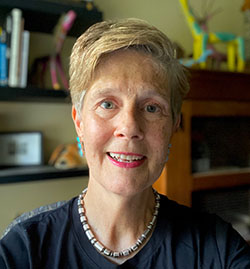 “I am extremely proud of the students who collaborated with NASA TV and the SolarSTEAM team to produce a four-hour plus live show,” Berry said.
“I am extremely proud of the students who collaborated with NASA TV and the SolarSTEAM team to produce a four-hour plus live show,” Berry said.
Berry’s students had a wide range of tasks for “the Karla show.” Some produced documentary clips, while others did social content such as “fun, flashy vertical videos,” according to cinema major Wobig. She pulled questions from the show’s Instagram feed and passed them on to experts to answer during the broadcast.
“I led a team that monitored social media and created content that got people excited about the eclipse, educated the public about space and kept followers updated on our live broadcast, the stadium show and the eclipse itself.”
All the students are worked regularly with eclipse chasers and other heliophysics experts.
Cinema major Alyssa Krueger said the number of people that base their lives around eclipses and studying the solar system is “crazy.”
“There’s so many people with so much knowledge,” she said. “It’s really nice that all of them are willing to share with us and tell us all of their experiences.”
Radio television and digital major Nathan Culli got to spend time with some of those people during an October trip to watch an annular eclipse in Midland, Texas, where he documented the science going on around it.
“It kind of prompts me for April’s eclipse to really see what totality is going to be like because I only got a hint of it.”
Radio, television and digital media major Gavin Melton was in SIU’s stadium during that annular eclipse, taking Berry’s class in the fall. He calls it a “surreal” experience.
“You feel really small in those moments,” he said.
Fellow student AJ Rice felt similarly when he witnessed his first total eclipse back in 2017.
“I was shocked at the perspective shift,” he said, “like how tiny you are in the world.”
Rice said it’s breathtaking to see two giant celestial objects interacting.
“I’ve always found it fascinating that the moon is just such a perfect size. If it were any bigger there would not be the cool corona,” he said.
Rice calls himself a “big science nerd” who listens to a ton of science podcasts. His comes into the project with a much different background than Culli.
“The extent of my astronomy knowledge before this was one unit in sixth-grade science,” Culli said.
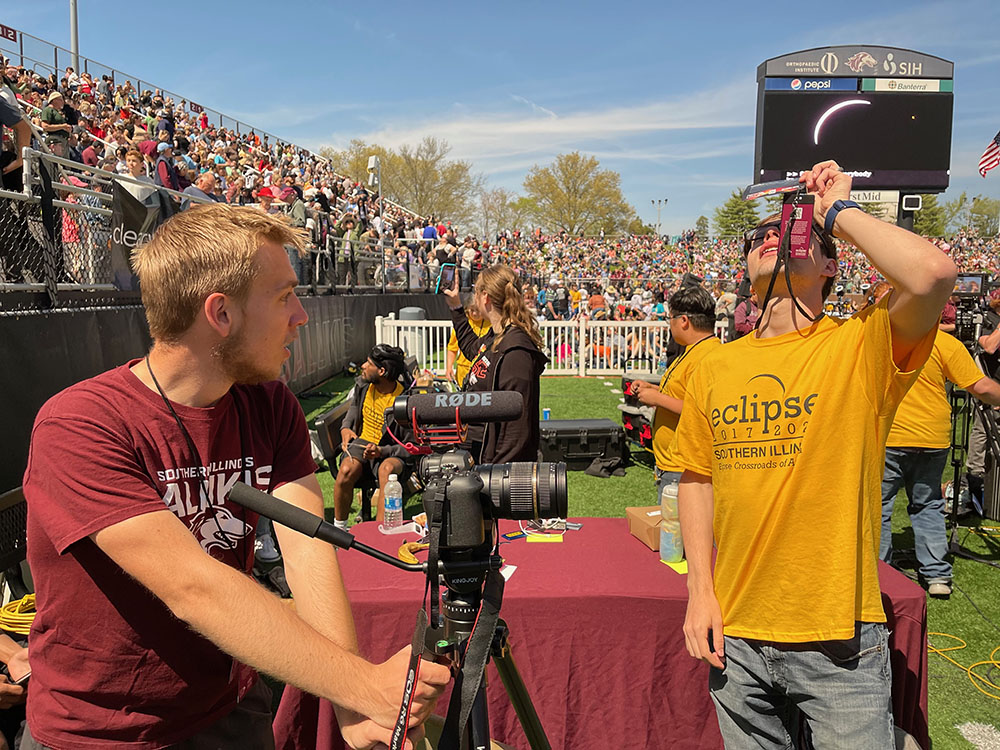 The students and Berry worked directly with NASA contractors on their production. The SolarSTEAM project was funded largely through a NASA grant.
The students and Berry worked directly with NASA contractors on their production. The SolarSTEAM project was funded largely through a NASA grant.
The Dynamic Eclipse Broadcast (DEB) Initiative was a network of citizen scientists that had telescopes set up along the path of totality. They fed content to Berry’s livestream.
It did not all go as planned however. Berry said there were “many” technical issues.
“It rained all day the day before the eclipse, and we did not get to practice,” she said. “All set up was left to the morning of the eclipse. … We were rolling right along until all the networks got overloaded as thousands of attendees arrived on campus with their mobile devices. … One astronomy student saved the day when he recommended we use one of the mobile switchers to stream the way he had in telescope practice. It worked.”
Wobig said it was “frustrating at times.”
“Schedules change, things fall through and mistakes get made, even in live productions, so to see everything come together one piece at a time was quite valuable,” she said.
Wobig is interested in producing and production management and working with social media.
“From this experience, I learned a lot about science and gained, not only a lot of professional film experience, but many fascinating stories I can tell for years to come,” she said.
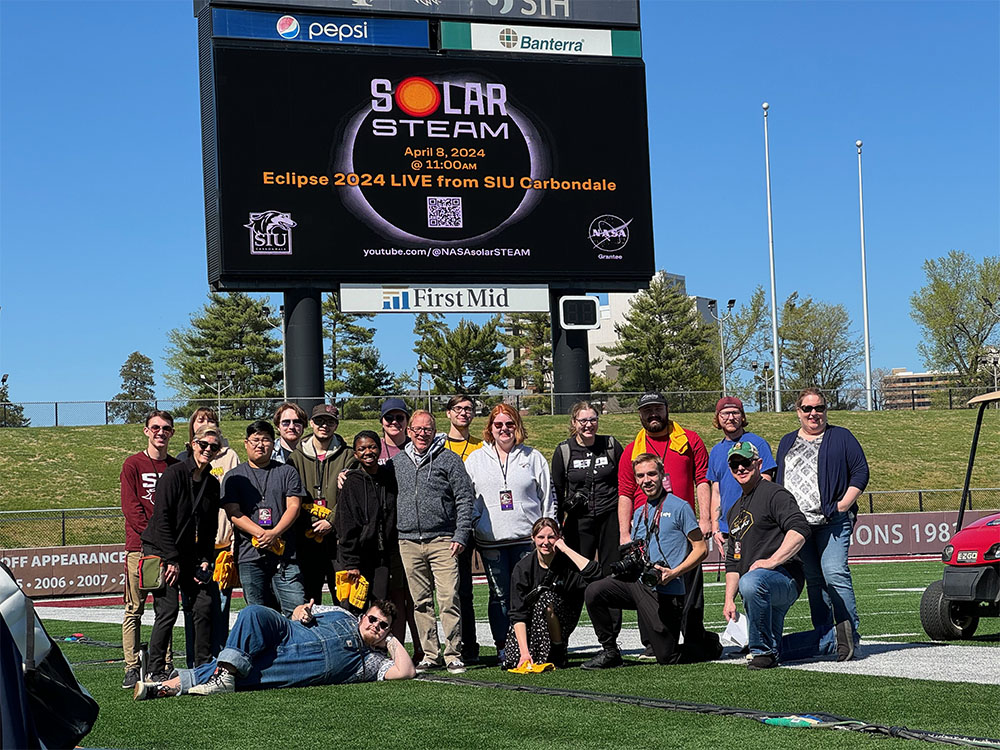 Berry took away some important lessons as well.
Berry took away some important lessons as well.
“I learned to ask better questions as a producer. The student learned to pivot in the moment,” she said.
Work on space topics isn’t over yet for Berry and her students.
“We’re part of SolarSTEAM and will collaborate with NASA TV/NASA Edge on a sky party live show in October,” she said.
That project will not be as big a production, and Berry will invite students to volunteer rather than have one class working specifically on the live show.
Fashion students showcase skills with eclipse designs and vintage garments
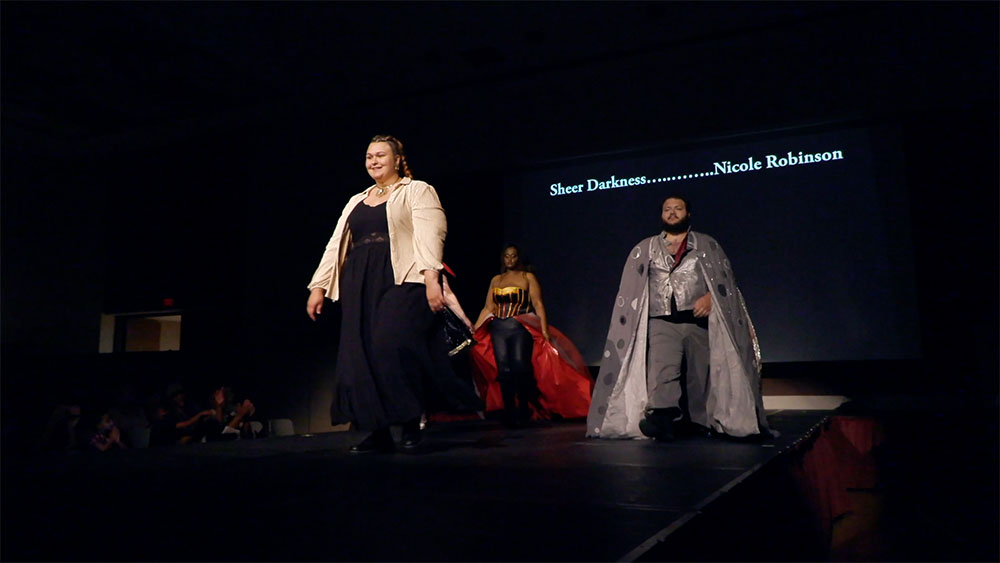 Student fashion designers channeled the total solar eclipse for their Fashion Studies’ Student Showcase Fashion Show on April 25 in the Student Center Ballroom.
Student fashion designers channeled the total solar eclipse for their Fashion Studies’ Student Showcase Fashion Show on April 25 in the Student Center Ballroom.
This year’s lines included eclipse-related garments, along with more typical clothes. The show doesn’t usually have a theme, but organizers wanted to tie it in with the biggest local event of the year.
Some of the students were each given a phase of the eclipse to inspire them. A junior going by the single name Lisa was assigned the after-effects of totality.
“So, I have two looks that are kind of like dark representing the actual eclipse and then my next two looks are, like, representing the flowers opening back up and like nature going back to its original phase,” she said.
Lisa’s work included a trio of bows, one sheer white with a narrow black ribbon, the others black with white accents. The white bow was for a dress, while the black ones were for the models’ hair.
“I’m definitely going through a bow phase right now,” she said.
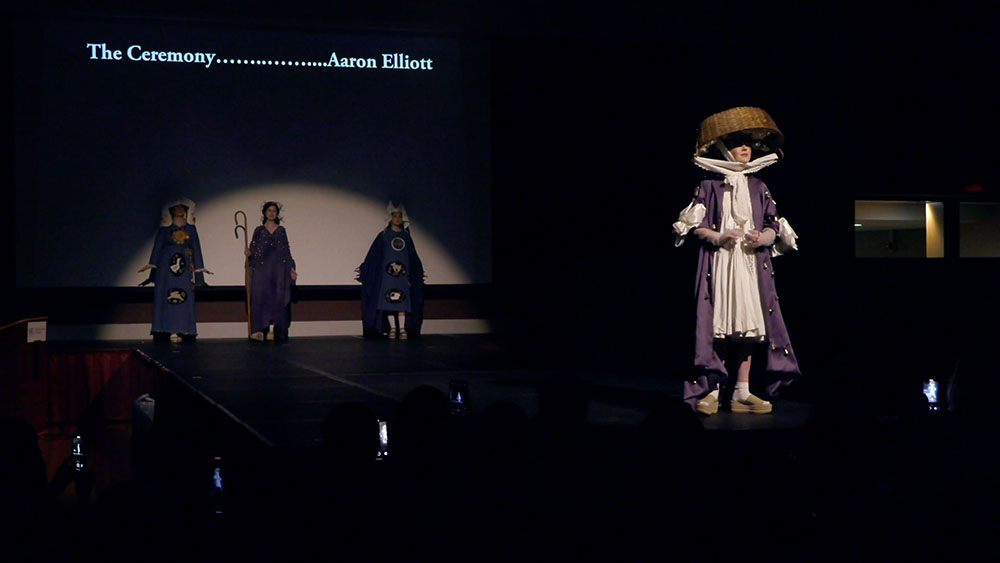 Junior Aaron Elliott was assigned the second interphase part of the eclipse, which produces a phenomenon called Bailey’s beads, an effect created when the outer rim of the moon’s typography allows only beads of light to pass through. To represent this, Elliott scattered small bells across a swath of denim.
Junior Aaron Elliott was assigned the second interphase part of the eclipse, which produces a phenomenon called Bailey’s beads, an effect created when the outer rim of the moon’s typography allows only beads of light to pass through. To represent this, Elliott scattered small bells across a swath of denim.
His collection heavily features the traditional fabric, as he favors American folk wear.
“I mean, what’s more American than denim,” he said.
Elliott also represented another phenomenon called the diamond ring effect by embroidering pieces of mirror on a dress to catch the light. He said the eclipse theme gave him direction.
“My interpretation of it was, what would you be like if you didn't know what a solar eclipse was? How would you want to do it? How would you celebrate it? So, I imagined that these people are trying to get the sun to come back, because the sun does give us life. So, these people are having a celebration of sorts,” he said.
Lisa said, despite having a common theme, the eclipse collections “couldn’t be less alike.”
“We all just kind of took it and ran with it basically,” she said.
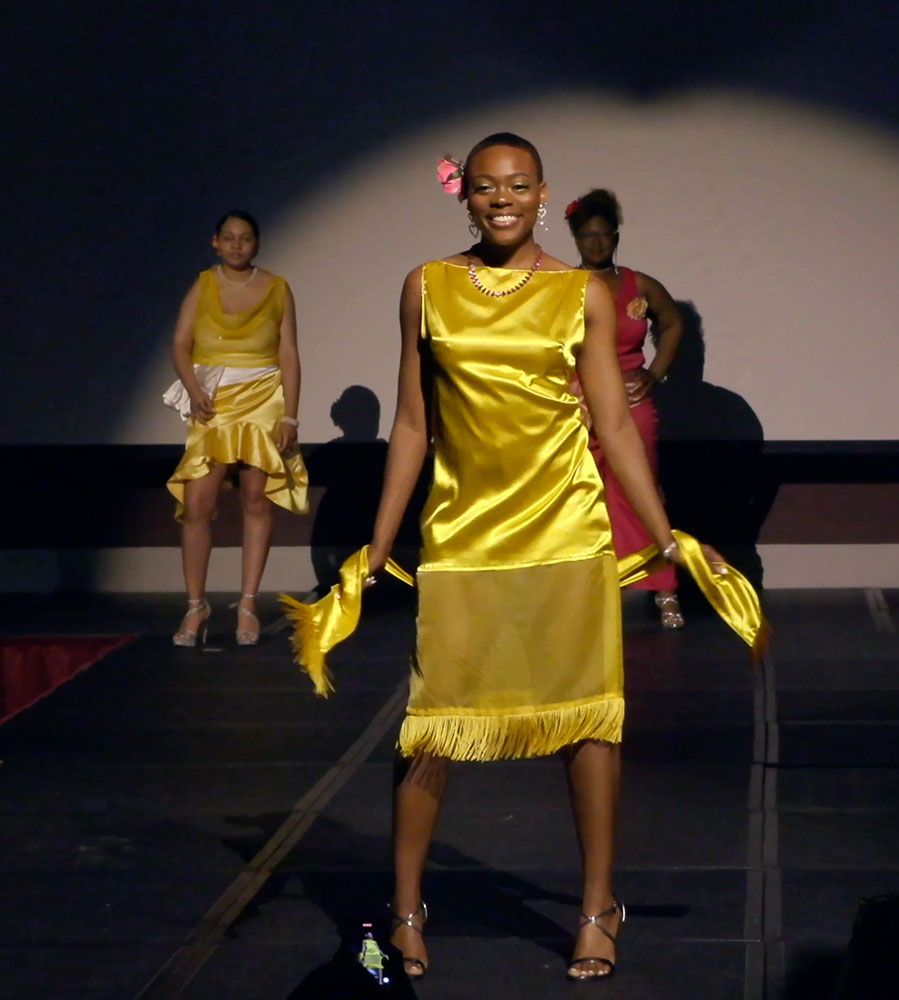 The student designers not working on eclipse garments based their designs on chosen decades. For senior Kylah Smith, that meant the 1930s.
The student designers not working on eclipse garments based their designs on chosen decades. For senior Kylah Smith, that meant the 1930s.
“Like any type of Harlem Renaissance time period, where fashion trends were like really big and what people were wearing was most important because, right after the Great Depression, clothes were starting to become a thing again, people were starting to be able to wear what they wanted, especially women. Women were able to start wearing pants instead of wearing dresses or skirts traditionally. So that's really what I wanted to focus on,” she said.
Her collection featured peaches and pinks contrasted with neutral shades. One of her pieces was a pink romper, the type of which was quite popular as beach wear in the ‘30s and is making a comeback today.
A freshman who goes simply by Jada also favored pink, creating a dress with bows designed to evoke a ‘70s ballerina’s outfit.
Jada said she doesn’t pay much attention to what’s happening in the wider fashion world.
“I feel like everybody has their own taste. I feel like that's the whole point of fashion is that everybody is very different. Everybody's bringing something to the table, you know. I try to just be more like, whatever I feel is more of my taste,” she said.
Student designer Noah Eaton went darker, harkening back to the film noir vibe of the 1940s.
He said the goal was to modernize a look while staying true to the vintage feel.
“I went with that sort of aesthetic of like trench coats and suiting. But my specific design perspective is sort of like genderless clothing that anyone can wear. So, I have like a suit gown, for instance, that a male model is wearing. And then my female model is wearing a trench coat look. And then I had another male model wearing a skirt,” Eaton said.
He said it’s important that the garments flow naturally while the model struts along the catwalk.
“If you want something really dramatic, the flow just lends itself to that,” Eaton said.
Freshman Chloe Antoine agreed. She had the longest dress in the show. She chose a colorful floral fabric to match the feel.
“It’s flowy, like something I could see myself in,” she said.
Antoine worked with her model, Emily Brinkman, to pick out the fabric.
“I just kept sending her pictures until we figured out what would look best with her skin tone and hair, what we could accessorize with it best,” Antoine said.
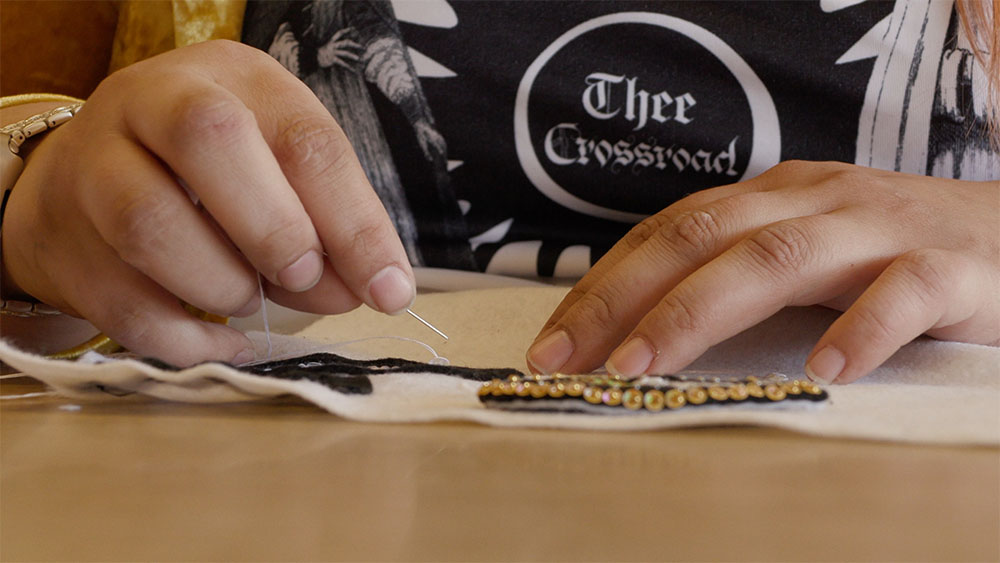 The student showcase allowed her to demonstrate her work, she said.
The student showcase allowed her to demonstrate her work, she said.
“I can actually show off my skills, what I did throughout the semester, a glimpse of what I could do in the future,” Antoine said.
Lisa was also excited for the chance to show off.
“It’s literally our blood, sweat and tears are going into this,” she said. “So, it’s definitely a big event that I always look forward to.”
Senior lecturer Judy Huyck said the showcase also lets parents see what their tuition dollars are being used for in a way that’s more effective than a grade report.
“They actually see what those grades reflect and what the students have put in and all the work that they have put in,” she said.
Hyuck said she hopes the audience came away saying: “’Wow! So, this is what this department does. This is what Fashion Studies in the School of Architecture puts out.’ Yeah. It’s a neat program, and the only one in the state of Illinois.”
Art and Design: Students create masterpieces at annual fall Iron Pour
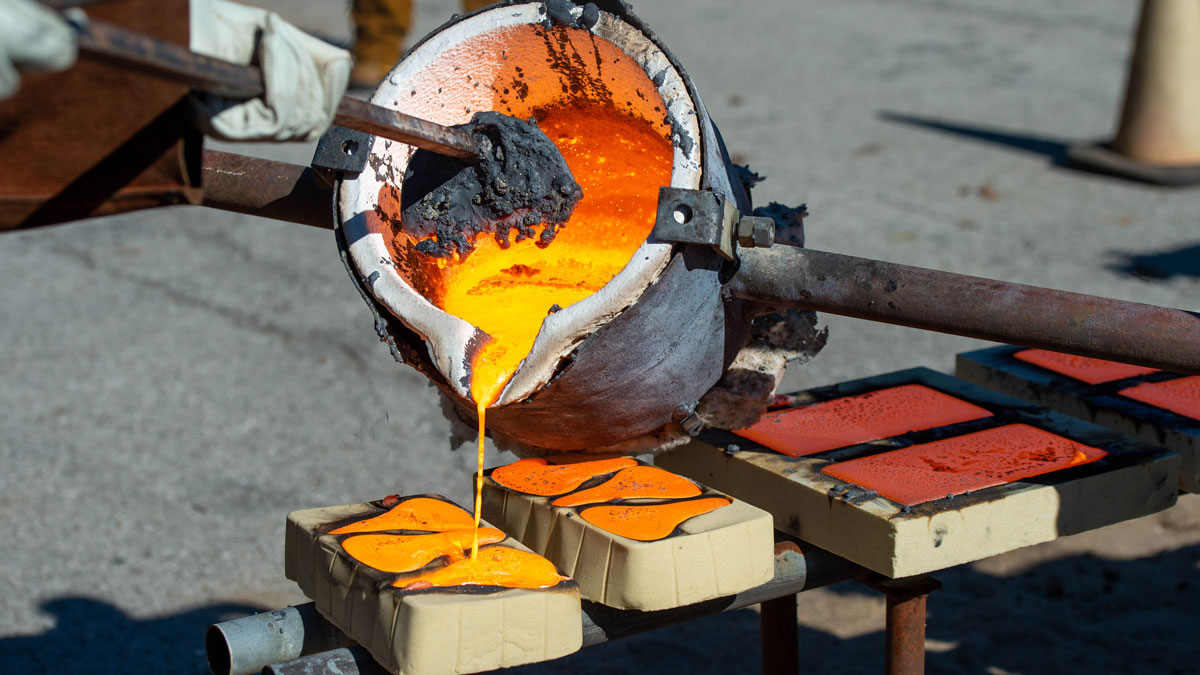 Two students dressed in leather and metal each hold one end of a long pole with a large ladle full of molten iron in the middle. They carefully pour the 3,000-degree metal into molds, creating artwork for students, faculty and staff, and members of the public. Then it’s back to the furnace, or copula, to start the process over again.
Two students dressed in leather and metal each hold one end of a long pole with a large ladle full of molten iron in the middle. They carefully pour the 3,000-degree metal into molds, creating artwork for students, faculty and staff, and members of the public. Then it’s back to the furnace, or copula, to start the process over again.
This year’s annual fall Iron Pour, which is free and open to the public, will be on Nov. 9, coinciding with the School of Art and Design’s Fall Arts Festival. Other activities include printmaking, blacksmithing and ceramics. Watch a video of the 2023 Iron Pour.
“We generally pour between 1,500 and 2,800 pounds, with some molds holding up to 250 pounds of hot metal,” said Alex Lopez, an associate professor of sculpture in the School of Art and Design.
The iron pour generally results in 30-70 pieces of student art, including body parts, animals, boxing gloves, bugs, hybrid creatures, shapes, tools, and even a wedding and prom dress, Lopez said. The public is welcome to participate.
“We sell scratch blocks in various shapes made of sand molds,” Lopez said. “The public renders their designs onto the tiles, and we cast them on site while they watch. We generally sell anywhere from 60-120 tiles.”
Safety is a top concern, with observers kept well back from the furnace and pouring areas.
“Everyone is suited up with leather or metalized safety gear from head to toe. In the casting world, they are known just as leathers. We also conduct dry runs on how things will happen and prepare for possible issues,” Lopez said. “A safety discussion happens before and on the day of the event. Everyone is assigned a task on the field, and students with little to no experience are teamed up with experienced students and faculty.”
Lopez said the pours help students prepare for various aspects of their careers. They can go on to graduate school, work in a foundry, serve as technicians for art programs, or teach and practice their own art.
SIU remembers beloved professor of journalism, political science
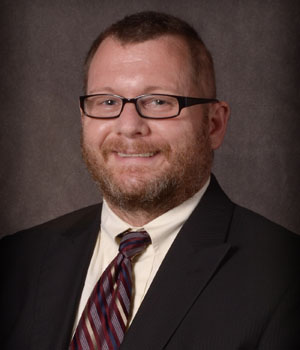 By Annie Hammock and Joei Younker
By Annie Hammock and Joei Younker
Southern Illinois University Carbondale professor Scott McClurg died April 13 after a long battle with brain cancer. He was 52 years old.
“Scott was a very good person. Very nice and considerate. Always positive and encouraging. His long fight with his illness was heroic. He will be dearly missed,” said Dong Han, an associate professor in the School of Journalism and Advertising.
Growing up in the St. Louis area, McClurg often swam in Coldwater Creek, which is now known to be contaminated with nuclear waste. He was the lead plaintiff in a lawsuit seeking compensation for the victims.
During the time of the Manhattan Project, uranium for the first nuclear bomb was refined in downtown St. Louis and the leftover radioactive waste was dumped near the creek. Many who played in the contaminated water or came in contact with it have had health concerns, including identical cancers.
“He lost so many classmates to different kinds of cancers,” said his wife, Jane McClurg.
While concerned activist group leaders in the area are working toward a resolution on a national level, there have not been any bills passed providing families with compensation for their struggles with the issue.
“I remember Scott once forwarded a news story on the nuclear dumping and the health problems of his high school class,” Han said.
Vicki Kreher, senior lecturer in the school of Journalism and Advertising said, “I sincerely hope something is done for the families of those who were affected by the Coldwater Creek contamination.”
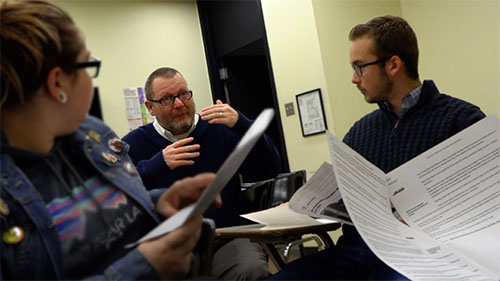 McClurg held a Ph.D. From Washington University. He joined the political science department at SIU as a full-time assistant professor in 2001. He received tenure and became a full-time associate professor in political science at SIU in 2007. He was promoted to full professor in political science in 2012 and joined the School of Journalism as a full professor in 2013.
McClurg held a Ph.D. From Washington University. He joined the political science department at SIU as a full-time assistant professor in 2001. He received tenure and became a full-time associate professor in political science at SIU in 2007. He was promoted to full professor in political science in 2012 and joined the School of Journalism as a full professor in 2013.
McClurg served as interim director of the School of Journalism and Advertising as well as interim chair of political science.
He is most recognized for his application of social network analysis to the study of political communication, with a particular focus on social influence.
Many of his colleagues are deeply feeling his loss.
“This is very sad. Scott provided great guidance to many of our students and was amazingly able to keep up his spirits during his long and difficult illness. He was a treasured colleague,” William Freivogel, a professor in the School of Journalism, said.
Jane McClurg said her husband, more than anything, wanted to inspire his students.
“He was so grateful to have those relationships with them and make a difference in their career paths and their lives,” she said. “He loved his job so much.”
Student Shatal Stellah joined mourners on Facebook with this tribute: “Reflecting back on my early days at SIU, I was overwhelmed with uncertainty. Everything felt daunting, from the classes to navigating campus life. Professor Scott, then the director of my program, became a beacon of support when I reached out to him, sharing my fears and apprehensions. His words of encouragement were a lifeline, assuring me that it was okay to feel uneasy and that I simply needed to take things one step at a time, while also emphasizing the importance of building connections. His kindness and guidance were pivotal in shaping my journey here, and I'm thriving today because of his belief in me.
Political science professor Ken Mulligan wrote that McClurg “had an immeasurably positive impact on countless students, colleagues, and friends, in the discipline of political science, at SIU, in Carbondale, and so many other places. He will be dearly missed.”
And friend Janet Burger Vaught wrote: “Tremendous loss to Carbondale, Southern Illinois University, the world of Political Science, and multitudes of friends and family members who loved and cared about him. He fought a brave battle and we are all going to miss his intellect, sense of humor, smiling face, and great laugh.”
In a 10-question interview with SIU in 2011, McClurg was asked what he would like his gravestone to say about him. He responded with, “why are you reading this, McClurg’s dead already. Go live, would ya?”
Theatre and Dance to present ‘A Christmas Carol’ in 1920s Cairo, Ill.
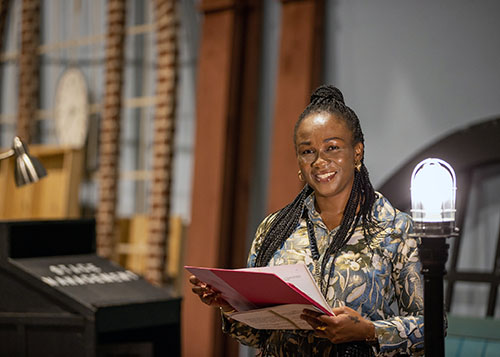 A time-honored Christmas classic will hit the Southern Illinois University Carbondale McLeod Theater stage in December in a setting completely different than 1860s Victorian England.
A time-honored Christmas classic will hit the Southern Illinois University Carbondale McLeod Theater stage in December in a setting completely different than 1860s Victorian England.
Relying on the adaption written by the late Darwin Payne, who was a longtime scenic design professor in the School of Theater and Dance, Kesiena Obue, a third-year Master of Fine Arts student in theater directing, will direct “A Christmas Carol” with the setting in 1920s Cairo, Illinois. Performances are set for Dec. 5-8.
A primary reason Obue chose Cairo as the setting was to bring the story “closer to home” for the audience, along with English novelist and author Charles Dickens’ descriptions of Cairo when visiting there in 1842 during a trip to the United States and traveling along the Ohio and Mississippi Rivers.
“I wanted this to be very relatable to the audience; I struggled with that for a bit. I was thinking how I justify bringing it to the United States,” said Obue, who learned of Dickens’ travels to the tip of Southern Illinois during her research. She was assigned “A Christmas Carol” for her thesis.
Dickens’ story addresses issues focused on social, cultural and political undercurrents and is “very reflective with what is going on right now in politics,” Obue said.
“There are a lot of things happening in the world right now. ‘A Christmas Carol’ tells this beautiful story of Christmas, but it also addresses humanity. It’s a reminder that we have to be kind and look out for each other,” she said.
“It costs nothing to be kind. We have to live for the moment, not just for you. Scrooge wanted to be Scrooge without a community. You cannot succeed without a community. You have to give back, be kind and show love.”
Has worked hard on the production
Obue said she has long been a fan of Payne’s work and would visit Morris Library to comb through his collection.
Payne, a Carbondale native and SIU Carbondale alumnus, was noted for his theatrical designs and dramatic adaptations, and he wrote books on design and art. A former chair in SIU’s theater department, Payne designed or directed more than 400 productions during his career. He died in 2016 at 85. Payne’s collection in Morris Library’s Special Collections Research Center includes set design sketches and drawings, watercolor or gouache set or costume renderings, research files, writings, manuscripts for his books on scenographic imagination and computer scenographics, scripts, playbills and correspondence.
Obue is staying with Payne’s adaptation but is adding music and dance to the 90-minute production. Auditions for the 20-member cast will be in the fall, with rehearsals planned to start in early October.
Obue admitted she’s a bit nervous about the project she’s been working on since December 2023.
“I’ve put a lot of work into this,” she said. “I believe the amount of work you put into a production determines how good it is going to turn out.”
The production will also be the thesis show for Aleka Fisher, a third-year MFA student in costume design, and a thesis qualifier for Charlie Lockridge, a second-year MFA student in technical direction. The scenic designer, MK Hughes, is an assistant professor in scenic design and an alumna of SIU's scenic design program — and the lighting designer, Jaemin Park, is an assistant professor in lighting and sound design.
Creativity is encouraged
The production is another example of students’ creativity, said H.D. Motyl, director of the School of Theater and Dance.
“We encourage our students to stretch themselves, to expand their creativity, and this is a great example of how to practice this — looking at a cherished classic and its inherent themes and then underscoring and magnifying them by using a different time and place,” Motyl said. “I was excited when I heard of Kesiena’s interpretation and I think audiences will be excited by it, too.”
Motyl added that the School of Theater and Dance is “excited to use this adaptation because it was written by one of our former faculty members. We are also honored to be able to partner with SIU Press, which happens to own the performance rights for this play.”
From microbiology to the arts
Obue had 10 years of professional experience in film and theater in her native Nigeria before coming to the United States three years ago to earn her MFA at SIU Carbondale. She plans to pursue her doctorate in filmmaking after she earns her master’s degree in December.
Obue earned her bachelor’s degree in microbiology from the University of Port Harcourt in Choba, Nigeria. and a post-graduate diploma in theater arts from the University of Ibadan, also in Nigeria.
“Microbiology was not me,” she said. “I found a calling in the arts.”
Support CAM
The College of Arts and Media needs your help to provide SIU students with the best experience possible. Please consider making a gift today by clicking the button below or by contacting Lisa Knight, director of development, or Michelle Snyder, assistant director of development, or call 618-889-4848.
